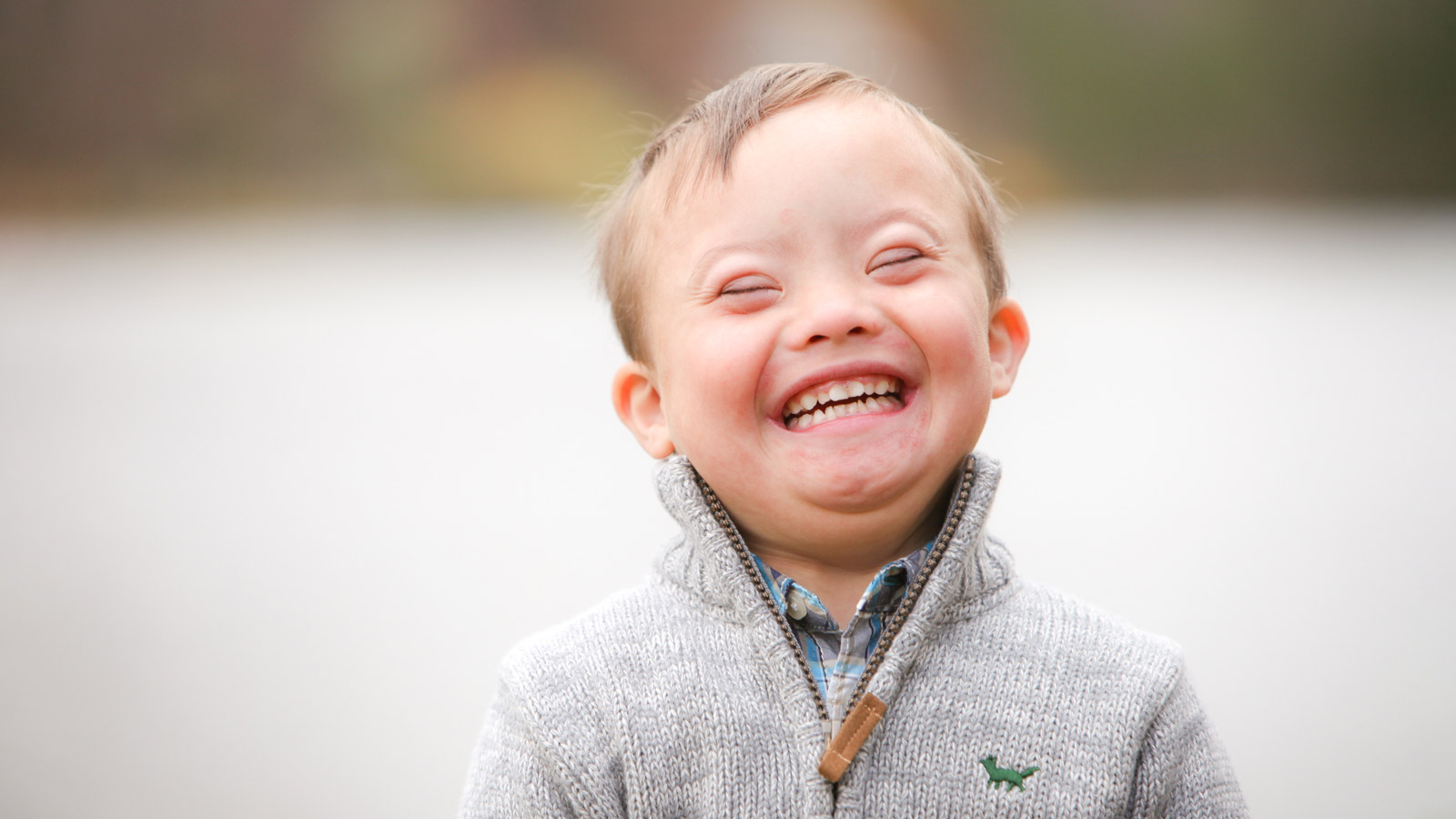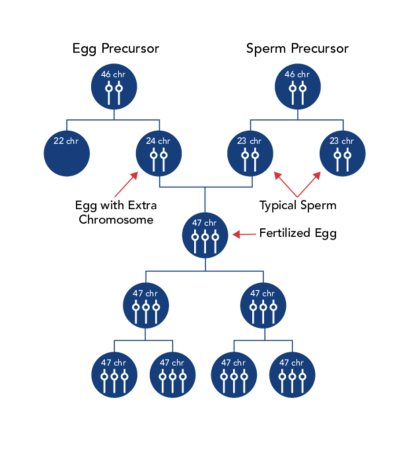In every cell in the human body there is a nucleus, where genetic material is stored in genes. Genes carry the codes responsible for all of our inherited traits and are grouped along rod-like structures called chromosomes. Typically, the nucleus of each cell contains 23 pairs of chromosomes, half of which are inherited from each parent. Down syndrome occurs when an individual has a full or partial extra copy of chromosome 21.
This additional genetic material alters the course of development and causes the characteristics associated with Down syndrome. A few of the common physical traits of Down syndrome are low muscle tone, small stature, an upward slant to the eyes, and a single deep crease across the center of the palm. Individuals with Down syndrome possess varying degrees of cognitive delays, from very mild to severe. Most people with Down syndrome have cognitive delays that are mild to moderate. Although each person with Down syndrome is a unique individual and may possess these characteristics to different degrees, or not at all.
Give today
Your donation will help people with Down syndrome, their families, and their caregivers.

How common is Down syndrome?
According to the Centers for Disease Control and Prevention, approximately one in every 775 babies in the United States is born with Down syndrome, making Down syndrome the most common chromosomal condition. About 5,000 babies with Down syndrome are born in the United States each year.
-De Graaf, G., Buckley, F., & Skotko, B. (2024, May 3). People living with Down syndrome in the USA: Births and Population. https://go.downsyndromepopulation.org/usa-factsheet
When was Down syndrome discovered?
For centuries, people with Down syndrome have been alluded to in art, literature, and science. It wasn’t until the late nineteenth century, however, that John Langdon Down, an English physician, published an accurate description of a person with Down syndrome. It was this scholarly work, published in 1866, that earned Down the recognition as the “father” of the syndrome. Although other people had previously recognized the characteristics of the syndrome, it was Down who described the condition as a distinct and separate entity.
In recent history, advances in medicine and science have enabled researchers to investigate the characteristics of people with Down syndrome. In 1959, the French physician Jérôme Lejeune identified Down syndrome as a chromosomal condition. Instead of the usual 46 chromosomes present in each cell, Lejeune observed 47 in the cells of individuals with Down syndrome. It was later determined that an extra partial or whole copy of chromosome 21 results in the characteristics associated with Down syndrome. In the year 2000, an international team of scientists successfully identified and catalogued each of the approximately 329 genes on chromosome 21. This accomplishment opened the door to great advances in Down syndrome research.
Are there different types of Down syndrome?
Trisomy 21 (Nondisjunction)
Down syndrome is usually caused by an error in cell division called “nondisjunction.” Nondisjunction results in an embryo with three copies of chromosome 21 instead of the usual two. Prior to or at conception, a pair of 21st chromosomes in either the sperm or the egg fails to separate. As the embryo develops, the extra chromosome is replicated in every cell of the body. This type of Down syndrome, which accounts for 95% of cases, is called trisomy 21.
Mosaicism
Mosaicism (or mosaic Down syndrome) is diagnosed when there is a mixture of two types of cells, some containing the usual 46 chromosomes and some containing 47. Those cells with 47 chromosomes contain an extra chromosome 21.
Mosaicism is the least common form of Down syndrome and accounts for only about 2% of all cases of Down syndrome (Facts about Down syndrome, 2021). Research has indicated that individuals with mosaic Down syndrome may have fewer characteristics of Down syndrome than those with other types of Down syndrome. However, broad generalizations are not possible due to the wide range of abilities people with Down syndrome possess.
Translocation
In translocation, which accounts for about 3% of cases of Down syndrome, the total number of chromosomes in the cells remains 46; however, an additional full or partial copy of chromosome 21 attaches to another chromosome, usually chromosome 14 (Facts and Down syndrome, 2021). The presence of the extra full or partial chromosome 21 causes the characteristics of Down syndrome.
What causes Down syndrome?
Regardless of the type of Down syndrome, a person may have, all people with Down syndrome have an extra, critical portion of chromosome 21 present in all or some of their cells.
The cause of the extra full or partial chromosome is still unknown. Age is the only factor that has been linked to an increased chance of having a baby with Down syndrome resulting from nondisjunction or mosaicism. However, due to higher birth rates in younger women, 51% of children with Down syndrome are born to women under 35 years of age. (De Graaf et al., 2022).
There is no definitive scientific research that indicates that Down syndrome is caused by environmental factors or the parents’ activities before or during pregnancy.
The additional partial or full copy of the 21st chromosome which causes Down syndrome can originate from either parent. Approximately 5% of the cases have been traced to the father.
A Promising Future Together
This booklet includes sections on healthy starts, early intervention therapies, how to find support and care for your family, and what the future holds for your child.

What is the likelihood of having a child with Down syndrome?
Down syndrome occurs in people of all races and economic levels, though older women have an increased chance of having a child with Down syndrome. A 35-year-old woman has about a one in 350 chance of conceiving a child with Down syndrome, and this chance increases gradually to 1 in 100 by age 40. At age 45 the incidence becomes approximately 1 in 30. The age of the mother, or birthing parent, does not seem to be linked to the risk of translocation.
Since many couples are postponing parenting until later in life, the incidence of Down syndrome conceptions is expected to increase. Therefore, genetic counseling for parents is becoming increasingly important. Still, many physicians are not fully informed about advising their patients about the incidences of Down syndrome, advancements in diagnosis, and the protocols for care and treatment of babies born with Down syndrome.
Does Down syndrome run in families?
All three types of Down syndrome are genetic conditions (relating to the genes), but only 1% of all cases of Down syndrome have a hereditary component (passed from parent to child through the genes). Heredity is not a factor in trisomy 21 (nondisjunction) and mosaicism. However, in one-third of cases of Down syndrome resulting from translocation, there is a hereditary component – accounting for about 1% of all cases of Down syndrome (Facts about Down syndrome, 2021).
The age of the parent does not seem to be linked to the risk of translocation. Most cases are sporadic – chance – events. However, in about one-third of cases, one parent is a carrier of a translocated chromosome.
What is the likelihood of having a second child with Down syndrome?
Once a parent has given birth to a baby with trisomy 21 (nondisjunction) or translocation, it is estimated that the chances of having another baby with trisomy 21 is 1 in 100 up until age 40.
The risk of recurrence of translocation is about 3% if the father is the carrier and 10-15% if the mother is the carrier. Genetic counseling can determine the origin of translocation.
| Maternal Age |
Incidence of Down syndrome |
|---|---|
| 20 | 1 in 2,000 |
| 21 | 1 in 1,700 |
| 22 | 1 in 1,500 |
| 23 | 1 in 1,400 |
| 24 | 1 in 1,300 |
| 25 | 1 in 1,200 |
| 26 | 1 in 1,100 |
| 27 | 1 in 1,050 |
| 28 | 1 in 1,000 |
| 29 | 1 in 950 |
| 30 | 1 in 900 |
| 31 | 1 in 800 |
| 32 | 1 in 720 |
| 33 | 1 in 600 |
| 34 | 1 in 450 |
| 35 | 1 in 350 |
| 36 | 1 in 300 |
| 37 | 1 in 250 |
| 38 | 1 in 200 |
| 39 | 1 in 150 |
| 40 | 1 in 100 |
| 41 | 1 in 80 |
| 42 | 1 in 70 |
| 43 | 1 in 50 |
| 44 | 1 in 40 |
| 45 | 1 in 30 |
| 46 | 1 in 25 |
| 47 | 1 in 20 |
| 48 | 1 in 15 |
| 49 | 1 in 10 |
How is Down syndrome diagnosed?
Prenatally
There are two categories of tests for Down syndrome that can be performed before a baby is born: screening tests and diagnostic tests. Prenatal screens estimate the chance of the fetus having Down syndrome. These tests do not tell you for sure whether your fetus has Down syndrome; they only provide a probability. Diagnostic tests, on the other hand, can provide a definitive diagnosis with almost 100% accuracy.
There is an extensive menu of prenatal screening tests now available for pregnant parents. Most screening tests involve a blood test and an ultrasound (sonogram). The blood tests (or serum screening tests) measure quantities of various substances in the blood of the parent. Together with age, these are used to estimate the chance of having a child with Down syndrome. These blood tests are often performed in conjunction with a detailed sonogram to check for “markers” (characteristics that some researchers feel may have a significant association with Down syndrome). New advanced prenatal screens are now able to detect chromosomal material from the fetus that is circulating in the maternal blood. These tests are not invasive (like the diagnostic tests below), but they provide a high accuracy rate. Still, all of these screens will not definitively diagnose Down syndrome. Prenatal screening and diagnostic tests are now routinely offered to all ages.
The diagnostic procedures available for prenatal diagnosis of Down syndrome are chorionic villus sampling (CVS) and amniocentesis. These procedures, which carry up to a 1% risk of causing a spontaneous termination (miscarriage), are nearly 100% accurate in diagnosing Down syndrome. Amniocentesis is usually performed in the second trimester between 15 and 20 weeks of gestation, CVS in the first trimester between 11 and 14 weeks (Chrionic villus sampling, 2020).
At Birth
Down syndrome is usually identified at birth by the presence of certain physical traits: low muscle tone, a single deep crease across the palm of the hand, a slightly flattened facial profile, and an upward slant to the eyes. Because these features may be present in babies without Down syndrome, a chromosomal analysis called a karyotype is done to confirm the diagnosis. To obtain a karyotype, doctors draw a blood sample to examine the baby’s cells. They photograph the chromosomes and then group them by size, number, and shape. By examining the karyotype, doctors can diagnose Down syndrome. Another genetic test called fluorescence in situ hybridization (FISH) can confirm a diagnosis in a shorter amount of time by visualizing and mapping the genetic material in an individual's cells.


What impact does Down syndrome have on society?
Individuals with Down syndrome are becoming increasingly integrated into society and community organizations, such as schools, health care systems, work forces, and social and recreational activities.
Due to advances in medical technology, individuals with Down syndrome are living longer than ever before. In 1910, children with Down syndrome were expected to survive to age nine. With the discovery of antibiotics, the average survival age increased to 19 or 20. Now, with recent advancements in clinical treatment, most particularly corrective heart surgeries, as many as 80% of adults with Down syndrome reach age 60, and many live even longer (Down syndrome, 2018). More and more Americans are interacting with individuals with Down syndrome, increasing the need for widespread public education and acceptance.
Preferred Language Guide
Use this language when referring to Down syndrome and people who have Down syndrome:
- People with Down syndrome should always be referred to as people first.
- Instead of “a Down syndrome child,” it should be “a child with Down syndrome.” Also avoid “Down’s child” and describing the condition as “Down’s,” as in, “He has Down’s.”
- Down syndrome is a condition or a syndrome, not a disease.
- People “have” Down syndrome, they do not “suffer from” it and are not “afflicted by” it.
- “Typically developing” or “typical” is preferred over “normal.”
- “Intellectual disability” or “cognitive disability” has replaced “mental retardation” as the appropriate term.
- NDSS strongly condemns the use of the word “retarded” in any derogatory context. Using this word is hurtful and suggests that people with disabilities are not competent.
Down vs. Down’s
- NDSS uses the preferred spelling, Down syndrome, rather than Down’s syndrome.
- Down syndrome is named for the English physician John Langdon Down, who characterized the condition, but did not have it. An “apostrophe s” connotes ownership or possession.
- While Down syndrome is listed in many dictionaries with both popular spellings (with or without an apostrophe s), the preferred usage in the United States is Down syndrome. The AP Stylebook recommends using “Down syndrome,” as well.
A downloadable version of the Preferred Language Guide is available to print and distribute.
Citations
Citations:
Chorionic villus sampling. Mayo Clinic. https://www.mayoclinic.org/tests-procedures/chorionic-villus-sampling/a…. Published November 12, 2020. Accessed June 28, 2022.
de Graaf G, Buckley F, Skotko B. People living with Down syndrome in the USA: BIRTHS AND POPULATION. May 2022. https://go.dselink.net/us-population-factsheet.
Down syndrome. Mayo Clinic. https://www.mayoclinic.org/diseases-conditions/down-syndrome/symptoms-c…. Published March 8, 2018. Accessed June 28, 2022.
Facts about Down syndrome. Centers for Disease Control and Prevention. https://www.cdc.gov/ncbddd/birthdefects/downsyndrome.html. Published April 6, 2021. Accessed June 28, 2022.








